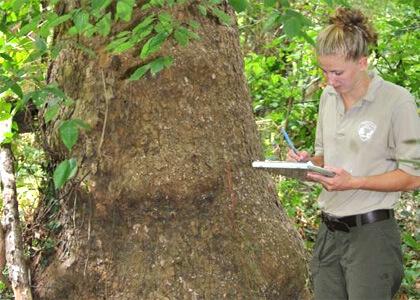I now know what the phrase “tick bomb” means. After spending the summer surveying for invasive plants in Fairfax County, VA, I consider myself quite the expert in not only exotic plants, but also species of ticks and their peculiarities.
I spent my summer working in Fairfax County, VA for the Fairfax County Park Authority (FCPA). Specifically, I worked in the Resource Management Division, which in my opinion of a complex government bureaucracy is the coolest department. FCPA oversees both natural and cultural resources in the county across 416 parks. Since Fairfax County is an integral part of the bustling metropolitan DC area, it is constantly developing and faces many resource management problems when dealing with its growing population.
Specifically, I worked with another intern to carry out a fledgling survey across as many FCPA parks as possible for non-native invasive plants. The NNIAP (Non-Native Invasive Assessment Prioritization) survey was performed using a standard field protocol in order to obtain an accurate rapid assessment of each park in terms of its invasive plant infestation level. This model was developed in the county for several reasons. It provides a solid foundation from which to work in terms of assessing the natural resources of a park, and creates a ranking system to help determine when each park should receive treatment. It is also a useful tool to have when visiting a park with a contractor to determine a chemical treatment plan, or when addressing the Board of Supervisors to procure funding to kill invasives each year!
I worked in the field 4-5 days a week, traipsing through parks and “breaking” them up into smaller parcels that are easier to look at from a management perspective. Parcels were broken up by changes in one or more of the factors the NNIAP survey takes into consideration: level of biodiversity, disturbance, percent infestation of exotic plants, difficulty of control, and visitation. Once a park was broken up into the appropriate number of parcels, scores were tallied for each and entered into a database in ArcMap along with their respective parcels to create a ranking system.
Working for the county government has been both rewarding and eye-opening. As a county employee, you have responsibility that many private companies do not have because your actions are accountable to the public. You have the power and opportunity to help conserve the county’s remaining natural resources that are threatened by development and greed, and you also have the responsibility to respond to demands from irate citizens about issues that may or may not be related to natural resources. Working for the county has also opened my eyes to some of the issues that you hear about so often in the news- particularly the slowness and complexity of the bureaucracy. Fortunately in Fairfax County these issues are not nearly as dramatic as other levels of government.
After spending the summer in what seemed like a new record heat each day, I can now appreciate even more the frustration that many people feel who work in the environmental field. I realize now that invasive plants are not something to eradicate but rather something to control in most circumstances, and that it is important to make smaller, achievable goals in order to not have your spirit crushed in such a mentally and physically overwhelming specialty like invasive plants. Of course, it is most important to make sure you carry a role of duct tape around your wrist during field work because you never know when or how many tick bombs you might hit in a day!

July 18, 2013